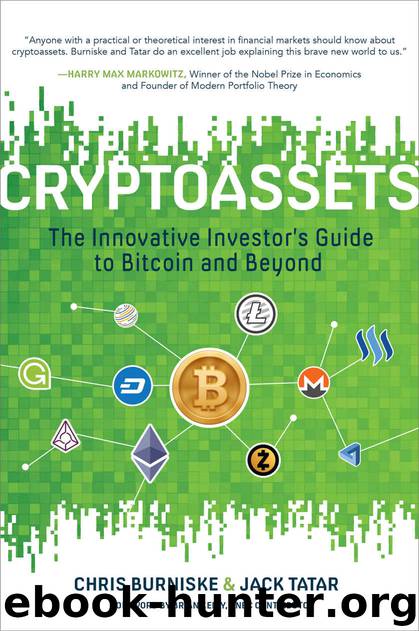Cryptoassets: The Innovative Investor's Guide to Bitcoin and Beyond by Chris Burniske & Jack Tatar

Author:Chris Burniske & Jack Tatar [Burniske, Chris]
Language: eng
Format: azw3
Publisher: McGraw-Hill Education
Published: 2017-10-20T04:00:00+00:00
PONZI SCHEMES
Ponzi schemes, also referred to as pyramid schemes, are the most dangerous type of misleading asset. While it got its name from Charles Ponzi, an Italian who lived from 1882 to 1949, it existed before he was born; he just made it famous.
The idea is simple: new investors pay old investors. As long as there are enough new investors, old investors will continue to be rewarded handsomely. For example, if an operator of a Ponzi scheme offered 20 percent returns into perpetuity, some investors would be duped into initially believing the operator. Call this “Batch A” of investors. The operator would encourage Batch A investors to tell their friends, who would become Batch B of even newer investors. The money Batch B investors invested would pay the 20 percent returns promised to the Batch A investors who brought them into the scheme. From there, Batch A and Batch B go and solicit Batch C, telling Batch C about this amazingly easy and rewarding investment product. The capital from Batch C goes to pay Batch A and Batch B, and so the Ponzi cycle continues indefinitely until there are not enough new investors to keep it going. The scheme falls apart when people realize no real value has been created, and everything is founded upon a scheme to dupe new investors into paying old investors. Tragically, investors often don’t realize they are duping one another, and it is the operator of the Ponzi scheme who makes out handsomely.
Before we turn to cryptoassets, let’s look at how Ponzi schemes have played out in traditional assets.
Many think of bonds as a safe investment with steady cash flows. If they are issued by a government, then they also have the full backing of that government. As we will soon see, bonds have not always been safe, and in what has been labeled the first emerging market boom, many bonds turned out to be Ponzi schemes.1
For about a century after the equity bubbles brought on by the Mississippi Company2 and South Sea Schemes3 (we’ll cover the shady dealings of these companies in the next section), British investors stuck close to government-issued bonds.4 During the Napoleonic Wars from 1803 to 1815, the British government issued over 400 million pounds of bonds, providing plenty of opportunity to bond investors. However, once peace reigned again, the British government had less need to borrow, and therefore the supply of government bonds shrank.5
At about the same time, South America was in the throes of rebellion against Spain, leading to the creation of new countries with a need for capital to build their infrastructure and join the developed world. An English newspaper claimed, “We may indulge the brightest hopes of these Southern Republics. They have entered upon a career of endless improvement. And … will soon attain the knowledge and freedom and civilization of the happiest states of Europe.”6
The opportunity to make money was the focus of hungry British investors, and it was fueled by stories of how British innovation
Download
This site does not store any files on its server. We only index and link to content provided by other sites. Please contact the content providers to delete copyright contents if any and email us, we'll remove relevant links or contents immediately.
Bad Blood by John Carreyrou(6274)
Rich Dad Poor Dad by Robert T. Kiyosaki(6174)
Principles: Life and Work by Ray Dalio(5957)
Playing to Win_ How Strategy Really Works by A.G. Lafley & Roger L. Martin(5493)
Management Strategies for the Cloud Revolution: How Cloud Computing Is Transforming Business and Why You Can't Afford to Be Left Behind by Charles Babcock(4438)
The Confidence Code by Katty Kay(4035)
Thinking in Bets by Annie Duke(3995)
American Kingpin by Nick Bilton(3507)
Delivering Happiness by Tony Hsieh(3280)
Project Animal Farm: An Accidental Journey into the Secret World of Farming and the Truth About Our Food by Sonia Faruqi(3016)
The Power of Habit by Charles Duhigg(2964)
Brotopia by Emily Chang(2892)
Mastering Bitcoin: Programming the Open Blockchain by Andreas M. Antonopoulos(2891)
The Tyranny of Metrics by Jerry Z. Muller(2846)
I Live in the Future & Here's How It Works by Nick Bilton(2844)
The Marketing Plan Handbook: Develop Big-Picture Marketing Plans for Pennies on the Dollar by Robert W. Bly(2792)
The Content Trap by Bharat Anand(2778)
Building a StoryBrand by Donald Miller(2754)
Applied Empathy by Michael Ventura(2749)
